
Written by Brian Kalman exclusively for SouthFront; Brian Kalman is a management professional in the marine transportation industry. He was an officer in the US Navy for eleven years. He currently resides and works in the Caribbean.

The Chinese government has achieved a great deal in terms of modernizing and increasing the capabilities of its armed forces in the past two decades. The Peoples’ Liberation Army (PLA) and its sister forces, the Peoples’ Liberation Army Air Force (PLAAF) and Peoples’ Liberation Army Navy (PLAN) are quickly obtaining parity with their counterparts in the West. China has made great strides along the long road to rebuild its military, so that it can compete and excel in the modern battlespace.
China has invested heavily in modernizing the PLAN over the past decade, designing and commissioning extremely capable vessels of all categories, and in increasing numbers. This attention to increasing the warfighting ability of its naval arm, belies a strategy on the part of the nation to not only strengthen the defense of its mainland territory and coastal waterways, but to acquire the ability to protect its maritime interests much farther afield and to project power well beyond what the West has delineated as its territorial borders.
Much has been written about the fledgling PLAN aircraft carrier program. With one conventional aircraft carrier in service, the Liaoning, and a second carrier being built, China has obviously made the commitment to acquire at least a small aircraft carrier strike capability. How China will utilize this new capability is the subject of much speculation. Large numbers of brand new logistics support vessels and surface combatants to comprise a very capable Carrier Battle Group (CBG) have already been built or are being built. China will have a viable conventional CBG is a few short years.
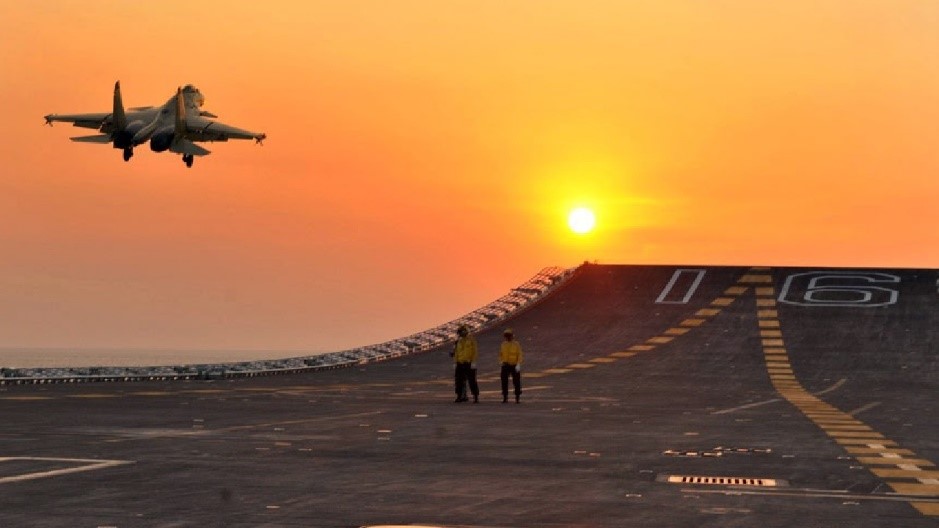
Naval flight operations onboard the first in class Liaoning aircraft carrier.
Another important development, perhaps less sensational and headline catching than aircraft carriers, is the growth and modernization of the amphibious capabilities of both the PLA and PLAN. Chinese military strategists realize that naval power, including naval aviation, can project power and can also provide China with the more subtle, yet very effective means of naval power presence in the region. The presence of Chinese naval power in the region can be leveraged to influence advantage in political struggles with its neighbors. Neither naval presence, nor naval power and naval air power can take (or retake) and hold ground, and thus China has decided that a modern and capable amphibious force of sufficient size is a necessary component of its overall maritime strategy. It is significant that this force has doubled in size over the past five years and has been equipped with new, high-tech weaponry and the beginnings of a viable sealift component that can carry it to battle.

PLA Type 071 LPD and five Type 072 LSTs during amphibious exercises 2015.

The beginnings of the Chinese interest in amphibious warfare dates back to the Korean War and the Peoples Republic of China’s efforts to defeat the Kuomintang in the 1950s. There is no doubt that the amphibious landings conducted by the United States during the Korean War and the subsequent conduct of that war had a great effect on PLA strategists. The success of the decisive landings at Inchon and the superb fighting qualities of U.S. Marines encountered during the fierce fighting in the Battle of Chosin (Changjin) Reservoir, had a lasting effect on Chinese military planners. The lessons learned in Korea occurred with the backdrop of the yet unfinished Chinese Civil War between the PLA and the Chinese Nationalist Army still holding out on Taiwan and a number of smaller islands. China lacked the amphibious capability to assault these islands, nor the naval power or airpower to support such and effort with any hope of success.
In 1953, the PLA established the PLA Marine Corps (PLAMC). This small force was disbanded in 1957, when the PRC abandoned the idea of storming the Island of Taiwan for the foreseeable future. The PLAMC was reborn in 1979, comprising of one marine brigade based on Hainan Island adjacent to the South China Sea. It appears that at this time, China desired a viable deterrent and response force to further altercations with the Vietnamese over the sovereignty of the Paracel Islands. During the 1990s, and the successive Taiwan Strait Crises that occurred during that decade, the PLAMC was expanded in size to two full strength brigades.

Although comprising of two brigades of approximately 6,000 officers and men, the PLAMC have undergone a continuous transformation since the Taiwan Strait Crises of the 1990s. The force has been equipped with China’s most modern and capable small arms and equipment, and utilizes the new generation of ZBD05/ZBD2000 amphibious assault vehicles. In some ways modeled on the USMC, the PLAMC marines are highly trained in all forms of modern warfighting. They train extensively in all climates and weather conditions, from desert to jungle, and even extreme cold conditions. They are considered a vital component of China’s rapid reaction forces, and are thus highly mobile and kept on a heightened state of readiness.
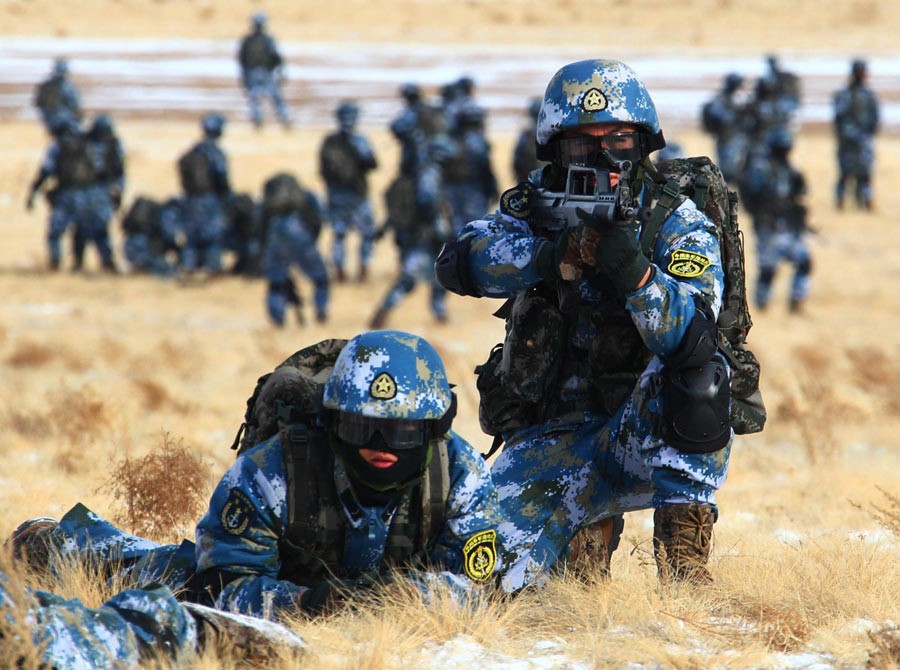
PLA Marines train in all environments and conditions. Above: PLA Marine exercises carried out in snow covered tundra in 2015.
The current force structure of the PLAMC is of two brigades, the 1st Marine Brigade and 164th Marine Brigade. Each brigade consists of one armored regiment and two marine battalions and various support elements:
PLAMC Brigade TO&E
- 1 Armored Regiment consisting of 1 x Battalion of ZBD(T)05/2000 Amphibious Assault Vehicles/Light Tanks and 2 x Battalions of ZBD05 Infantry Fighting vehicles.
- 2 Marine Battalions which are mechanized and equipped with ZBD05 APCs and IFVs.
- 1 Self-Propelled Artillery Battalion equipped with PLZ-07B 122mm SPGs which are amphibious.
- 1 Missile Battalion of AT and AA missiles.
- 1 Engineer Battalion
- 1 Communications Battalion
- 1 Field Maintenance Battalion
Although major amphibious exercises conducted in 2015 and 2016 showcased the use of Type 96 MBTs in amphibious assaults, these armored units most likely came from one of the PLA’s two Amphibious Mechanized Infantry Divisions, and not PLAMC armored regiments. Although heavier armored vehicles can be delivered to beachheads rapidly by PLAN hovercrafts, the PLAMC relies on the high speed of its ZBD05/2000 series vehicles to carry them from offshore amphibious platforms such as the Type 071 LPD. The ZBD05 is the world’s fastest armored amphibious assault vehicle, capable of a top speed of 45kph (27mph) in the water. In addition, PLA marines are skilled in air assault operations, small boat assaults and underwater diving operations.
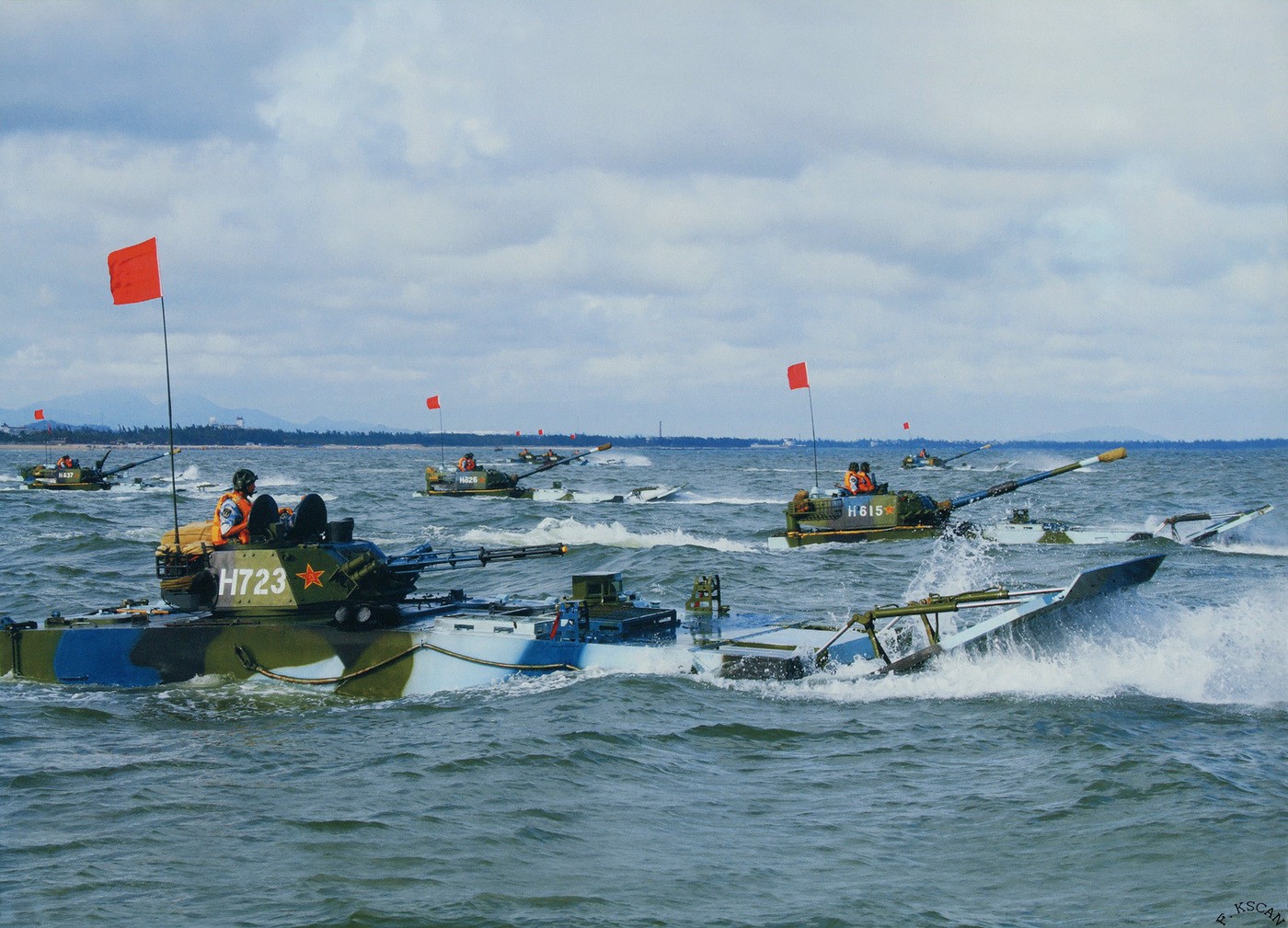
PLA Marines practicing amphibious landings with ZBD05 IFVs and ZBT05 light tanks. These amphibious armored vehicles provide a balance of speed, flexibility and firepower.

*AMID – Amphibious Mechanized Infantry Divisions
Although the PLAMC represents a very potent amphibious assault and rapid reaction force, the Chinese political and military leadership realized years ago, that the force is too small to respond to multiple threats across the full scope of China’s maritime boundaries, nor large enough to mount a successful invasion of Taiwan. As China continues to expand its maritime reach farther afield, and looks to operate overseas bases, such as the base being opened in Obock, Djibouti, the decision to expand the amphibious capabilities of the armed forces was an easy one. With over $30 billion USD invested in Africa, the Obock base will allow China to support a continued naval presence in the Horn of Africa, where it will be positioned to protect its interests in the region. A viable power projection capability in the form of amphibious assault and air assault forces is seen as essential in protecting the nation’s interests in Africa, the Indian Ocean, South China Sea and East China Sea, especially as it is confronted by U.S. attempts to contain it.
Starting in 2014, the Chinese high command decided to expand the two established Amphibious Mechanized Infantry Divisions (AMID) to four. These divisions are under the command of the PLA, while the PLAMC come under the command of the PLAN. Perhaps one of the largest challenges facing the successful utilization of the AMIDs in complex military operations, is the issue of command and control across the two branches of service. China acknowledged this early, and the complex amphibious exercises conducted over the past two years exhibit efforts to confront and master these complex command and control issues.
There are four AMIDs currently established in the PLA. The 1st and 86th AMIDs based in the Nanjing Military Region (Eastern Command), and the 123rd and 124th AMIDs based in the Guangzhou Military Region (Southern Command). Each division is comparable to a mechanized infantry division, with the addition of high endurance amphibious vehicles such as the ZBD05/2000 family of vehicles.
Amphibious Mechanized Infantry Division TO&E
- 2 Amphibious Mechanized Infantry Regiments
- 1 Amphibious Armored Regiment
- 1 Artillery Regiment
- 1 Air Defense Artillery Regiment
- Various support elements including Engineers, Signals and Communications, and Field Maintenance.
The expansion of the AMIDs gives the PLA a greater amphibious capability that might be required in the near future in deterring regional challenges to Chinese territorial claims in both the South and East China Seas, and providing a viable response to violations of its territorial integrity. Although diplomatic overtures by the new Philippine President, Rodrigo Duterte, have helped to calm any possible inflaming of territorial disputes between the two nations in the South China Sea following the PAC ruling this summer, Japan has apparently decided to fill the spot vacated by the Philippines. Japan has announced plans to partner with the United States in “freedom of navigation” patrols in the area. Japan has decided to insert itself into a dispute that it previously had no interest in. This is undoubtedly linked to a deterioration of relations between China and Japan over territorial disputes in the East China Sea, centered on the Senkaku/Diaoyu Islands. Japan is also increasing its own amphibious warfare capabilities to challenge Chinese claims over what it sees as its own sovereign territory.
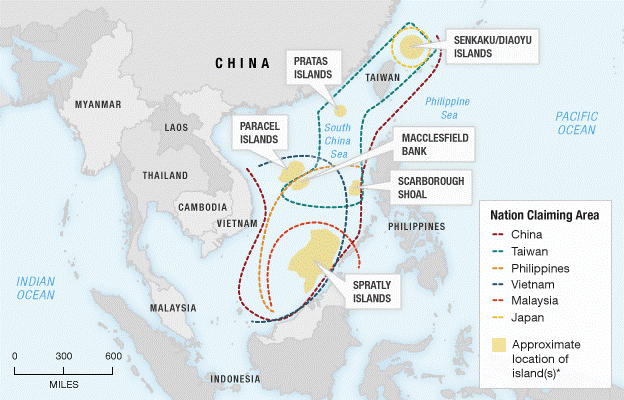
The many overlapping territorial disputes that challenge China and its regional neighbors.
None of China’s potential adversaries in the region, other than the United States Navy, have a comparable amphibious warfare force. When combined with the PLAMC, the AMIDS give Chinese diplomacy a very robust practical demonstration of force. Regularly held amphibious exercises showcasing the growing aptitude of these forces only reinforce this reality. Perhaps the most obvious challenges facing the marines and AMIDs, and a major shortcoming that is in the process of remedy, is the lack of heavy sealift capability to transport these units over long sea voyages and within striking range of their theoretical targets.

As stated earlier, China’s amphibious forces have experienced both a growth in number and capability over the past two decades. The Chinese military continues to be reduced and streamlined, transforming from a mostly conscript force, to a highly trained professional military. China has been successful in reforming its military institutions, as well as investing wisely in new, high tech weapons systems, communications and information technology management systems, and targeting and tracking radars. All of these factors have created an extremely nimble and powerful amphibious warfare force. The one component that is currently lacking, though in the process of correction, is the lack of modern sealift for China’s expanded amphibious capability.
Type 071 LPD
Beginning in 2006 with the launch of the Kunlun Shan #998, China started along the road to modernizing its amphibious assault capabilities. The first vessel of the Type 071 class Amphibious Transport Dock (LPD), the Kunlun Shan, is the first of six vessels planned. Four vessels have been launched and commissioned since December 0f 2006. These LPDs are equipped with an aft flight deck and hangar to support helicopter operations, and a well deck to allow amphibious assaults via AAVs, landing craft or LCAC (Landing Craft Air Cushioned) hovercraft. Each vessel is equipped with a hospital, ample cargo space for the provision of disaster relief supplies and or light vehicles, and room to house a troop complement of approximately 500 to 800 troops dependent on the mission. The LPD has the inherent flexibility to provide over the horizon air assault and amphibious assault capability.
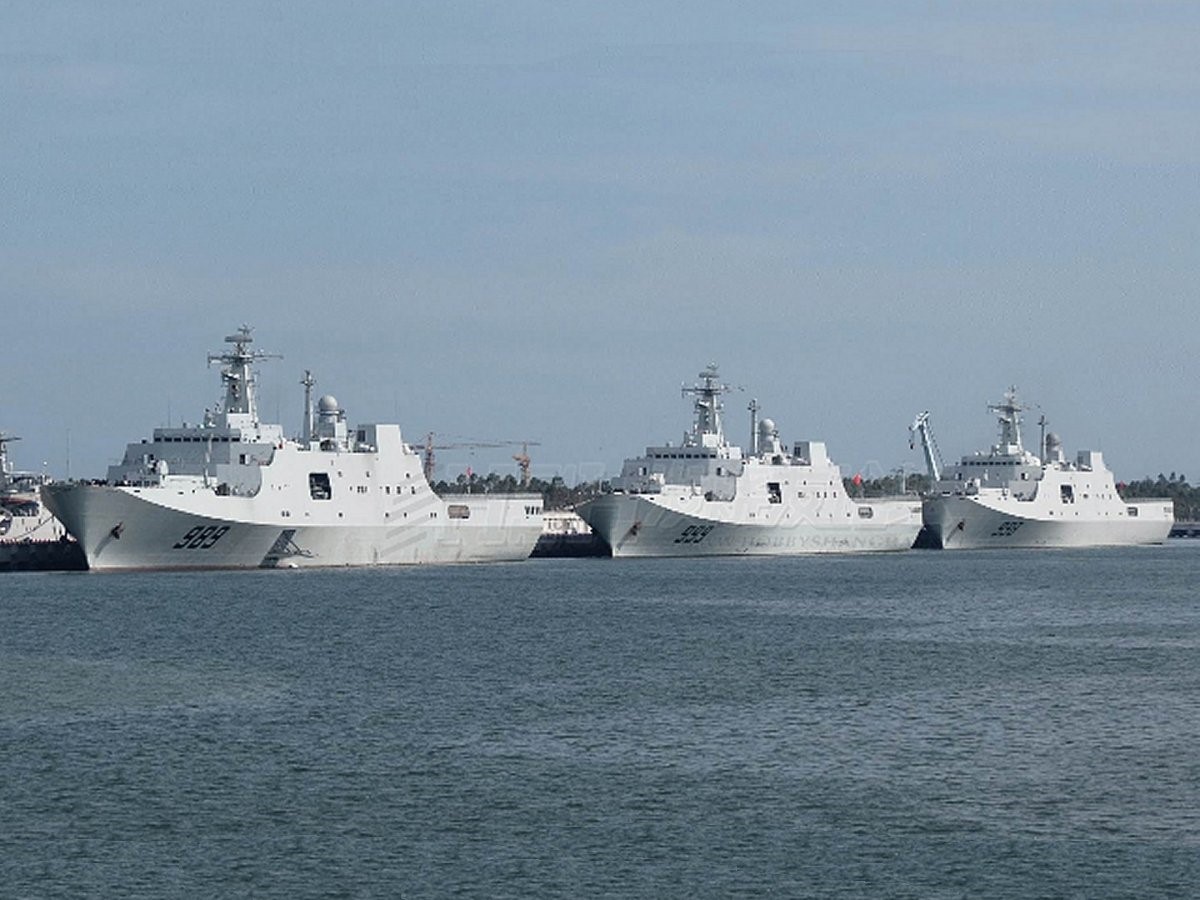
Three of the four Type 071 LPDs currently in service docked in southern China.
The LPD is the perfect platform to respond to both military incursions into disputed island territories such as the Spratly and Paracel Islands, as well as a support platform for Chinese island bases in these areas. The LPD is very well suited to respond to humanitarian disasters in the region, due to its capabilities and inherent flexibility. It is smaller and has a shallower draft than a larger Landing Helicopter Dock (LHD), and can thus gain entry to areas of minimal maritime infrastructure in cases of responding to humanitarian disasters. In areas prone to hurricanes and flooding, such as Southeast Asia, the LPD is a valuable tool in Humanitarian Assistance Disaster Relief (HADR) operations.
Type 072A LST
The PLAN has 15 Type 072A Class LSTs in service. It is unclear how many total vessels are planned, but it is surmised that the Type 072A is meant to replace older Type 072 and Type 072II Class LSTs. Similar in design to its predecessor, the Type 072III Class, the Type 072A has a more streamlined superstructure, and a well deck designed to accommodate an LCAC. The vessel has a small flight deck that can accommodate one helicopter, and enough underdeck space to stow a maximum of 10 MBTs, or 500 tons worth of light vehicles and cargo. Approximately 250 to 300 troops can be accommodated.
There are a total of 32 Type 072 LSTs of all classes in service with the PLAN. These LSTs are traditional amphibious assault vessels that are loaded via a stern ramp and are beached bow-first during an assault. Egress is via bow doors that open to allow a bow ramp to be lowered so that vehicles and troops can exit the ship. The Type 072A can facilitate the launch and recovery of LCACs at sea due to the provision of a true well deck, similar to an LPD, LSD or LHD. The design of the LST and its beaching method of discharge give the vessel a very shallow draft, which is only 2.8 meters (9.2ft.) in the case of the Type 072A.

Type 072III LST landing ZBT05 amphibious assault vehicles via its bow ramp.
Zubr Assault Landing Hovercrafts and LCACs
China has made a significant effort to acquire large air cushioned landing craft, both indigenously and from abroad. In 2009 the Chinese government signed a deal with a Ukrainian firm to purchase two Zubr Class heavy assault hovercraft and the license to manufacture two more in China. These four craft have been supplemented by an additional four purchased from the Greek Navy. The largest combat hovercraft in the world, the Zubr can carry a 150 ton payload at a range of 300 miles at a speed of 40 knots. The advantage of air cushioned vessels is that they can carry their payload of troops and vehicles inland from the sea, traveling beyond the beach and deeper inland. This capability gives military planners more options when combined with traditional amphibious assaults and air assault operations. Given the significant payload of the Zubr, a maximum of three Type 96 MBTs can be transported quickly to the battlefield, and deployed behind enemy lines.
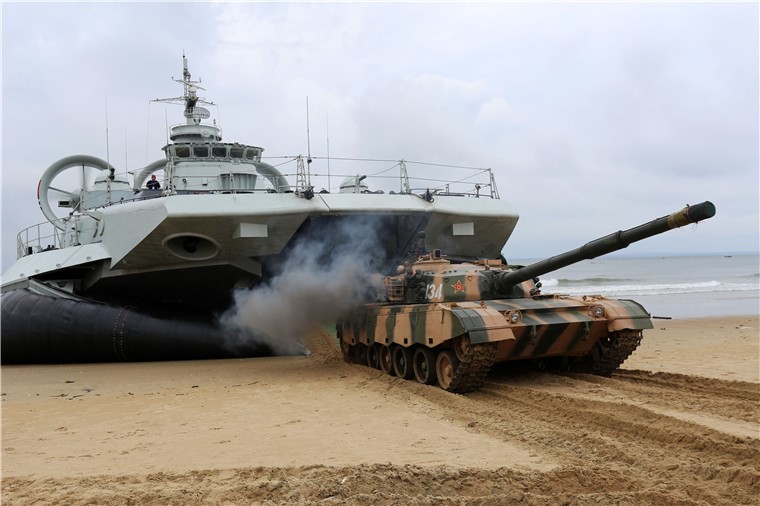
Zubr Class assault hovercraft discharging a Type 96 MBT during amphibious exercises in 2015.
Type 726 Yuyi Class LCAC
China has produced an LCAC similar in design as the U.S. Navy LCAC, but it is smaller and carries a smaller payload. The Type 726 Yuyi was designed to be carried in the well deck of the Type 071 LPD, which can accommodate four of these hovercraft. The Yuyi can carry a payload of 60 tons at a speed of 60 knots. China has only been producing these LCACs for a few years and the total number in active service is unknown; however, it can be assumed that the PLAN will require 4 LCACs per Type 071 LPD that is in service. It is also very probable that additional LCACs will be required for the Type 075 LHD that is still in the planning stages of development.
Type 075/Type 081 Landing Helicopter Dock (LHD)
A number of different concepts and models have been shown to the public that clearly showcase the PLAN desire to field an LHD in the immediate future. The utility and flexibility of such a platform has been widely recognized and embraced by every major navy in the world. A detailed analysis of this trend can be found here: (Miltiary Analysis: Multirole Naval Platforms of the 21st Century). All of China’s potential adversaries in the region, including Japan, Australia, South Korea and the United States, have large Multirole Naval Platforms (MNP) in service. A large LHD, LHA or DDH offers increased flexibility and additional options to military planners, and forces potential adversaries to alter their strategic calculus accordingly.
It is foreseeable that the PLAN would attempt to field an LHD or two in both the Southern and Eastern Military Regions, positioning them to respond to territorial provocations or sovereignty infringements. LHDs are extremely useful in carrying out successful HADR operations as well. There large size and endurance allow them to bring massive amounts of material aid and humanitarian support in events of crisis. China could earn political victories in the region by aiding its neighbors in times of humanitarian disaster with such a valuable tool.
The planned dimensions and specifications of the various designs presented to the public envision an LHD of very large displacement. At between 36,000 and 40,000 tons displacement, the vessel is much larger that the Royal Australian Navy Canberra Class LHD which weighs in at 27,500 tons. It is also larger than the Japanese Maritime Self Defense Force Izumo Class DDH, which comes in at 27,000 tons. It is closer in displacement to the U.S. Navy Wasp Class LHD, which displaces 41,000 tons. Unless the PLAN is determined to operate fixed-wing VSTOL aircraft from the new vessel, as the Wasp Class LHD currently does, such a large size denotes an increased helicopter air assault capability above and beyond contemporary LHD design, or a significant cargo and amphibious assault capacity. Taking note of their penchant for emulating U.S. designs, the Chinese naval architects may envision a vessel close in design and capacity to the Wasp Class, or even a scaled down America Class LHA.

The Type 075 Class LHD Concept (top) in comparison to the U.S. Navy Wasp Class LHD (bottom) currently in service with the U.S. Navy.

China has a growing list of reasons to pursue an expansion of its amphibious warfare capability. Not only does China confront challenges to its perceived territorial integrity form a host of regional neighbors, but it is more actively being challenged in the greater geopolitical sense by the United States. The United States is trying to contain an increasingly empowered China, at a time when China’s growing global interests and influence are in the ascension. Such a combination will undoubtedly lead to political and diplomatic conflict, if not military conflict at some time in the not too distant future. China must prepare itself for this eventuality and develop the means to protect its national interests at greater geographical range. As it backs up its territorial claims in real terms, by developing settlements, military bases and early warning stations on a host of islands in disputed waters, it must have a viable amphibious warfare deterrent and the means by which to wrest control of any of these assets back from hostile invaders.
The South China Sea Dispute
In or to support and defend a chain of small islands in both the Paracel and Spratly Archipelagos, China will need to develop a powerful and flexible amphibious warfare force that can respond rapidly to threats from the various parties who claim sovereignty over the area, and an increasingly probable and credible challenge from the United States. The recent official announcement that the JMSDF will be participating in future “freedom of navigation” patrols alongside the U.S. Navy, only adds impetus to this fact. China is obviously moving toward the creation of a viable AD/A2 capability in the South China Sea. The creation of a rapid reaction amphibious ready group (ARG) is the next step in protecting its claims in the region.
The Senkaku/Diaoyu Islands Dispute
The territorial dispute between China and Japan over the Senkaku/Diaoyu Islands has heated up anew this year, and most notably after the PCA ruling in July. China has sent large groups of unarmed survey vessels and fishing vessels into the territorial waters of these islands, as well as a small number of armed China Coast Guard vessels since the ruling was made public. Japan has been forced to dispatch its own Coast Guard vessels in response. Japanese officials announced their intention to develop a new missile system to defend the islands in August, and are continuing to develop Japan’s own amphibious capabilities. The Ground Defense Forces Western Army Infantry Regiment has been training with the USMC in amphibious warfare starting in 2014 and will form the core of a rapid reaction force developed for deployment from JMSDF LST and DDH vessels. Japan intends to build an amphibious brigade around the nucleus of the Western Army Infantry Regiment, complete with 52 AAVs and 17 V-22 Osprey tilt-rotor aircraft.
China has responded by conducting aerial exercises in the area, dispatching large groups of fighters, aerial tankers and surveillance aircraft to the airspace over the disputed islands. China created an Air Defense Identification Zone (ADIZ) in the area in late 2013 in response to the Japanese government purchasing one of the islands from its private owner. As this dispute becomes more contentious, both sides will continue to ready amphibious forces as a contingency.
The Issue of Taiwan
Without a doubt, the longest running territorial sovereignty dispute between China and another nation, is the issue of Taiwan. The Republic of China (Taiwan) is recognized as an independent nation by some nations, an integral part of China by others, and also as an autonomous, yet intrinsic part of China by still a majority of nations. The “One China Policy” has existed in all its ambiguity for decades, with no definitive end anywhere in sight. Successive Chinese and Taiwanese governments have worked mostly towards maintaining the status quo in recent decades. Even pro-independence presidents of Taiwan have seen the futility of declaring official independence.
Although China presently lacks the capability of invading and seizing the island by military means, the current trend does not bode well for Taiwanese independence. As the PLAN expands, fielding more powerful vessels in greater numbers, especially its amphibious sealift capability, there will come a time in the not too distant future, when China will possess the ability to seize the island by force. Such an undertaking would be extremely costly to both sides. A powerful amphibious warfare force will most likely be used more as diplomatic leverage in attempting a peaceful reunification of the two Chinas.
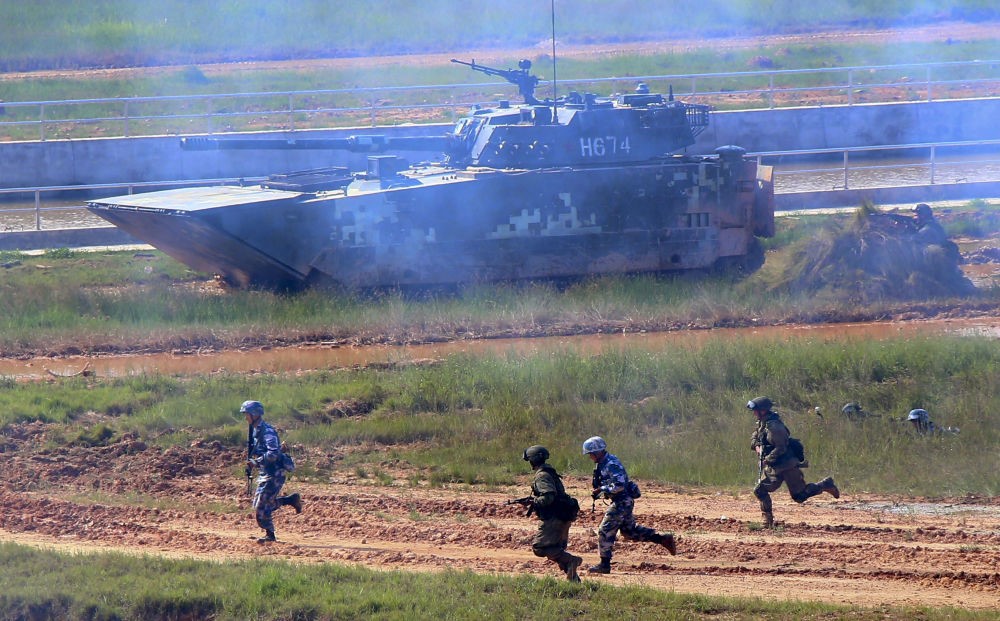
Chinese and Russian marines conducting joint amphibious exercises during “Joint Sea 2015” near Vladivostok. Similar exercises were conducted in August of this year in the South China Sea.

China is reinventing its armed forces for the 21st century. This has required a total reevaluation of how it aims to employ its military in the near future, and over the next century. An insightful observer has seen a methodical attempt to streamline, modernize and professionalize a once unwieldy conscript military into a highly capable professional fighting force. Challenges to Chinese military, economic and political influence around the globe are legion. As China’s power is waxing, the waning power of the United States hopes to stymie and contain what it sees as an unwelcome challenger. Having announced a “Pivot to Asia” in his first term, President Obama made this reality quite clear. In the intervening years, especially so over the past two, the United States has worked tirelessly to foment discord in the region, capitalizing on territorial disputes between China and its neighbors, and increasingly militarizing the region.
The Chinese political apparatus, and its naval leadership understand the need of a viable amphibious warfare force, both as a deterrent and as a tool to be used to protect China’s national interests. These national interests involve maintaining China’s territorial integrity at home, and in protecting its national interests far from its shores. It is very probable, in light of the PLAN’s current pace of building and mastering complex naval operations, that the world will witness the deployment of a Chinese aircraft carrier battle group or an integrated, aircraft carrier-reinforced amphibious ready group by the year 2025.
It is most likely that the United States will continue in its belligerent attempts to contain a perceived adversary, as opposed to realizing the inevitability of the return to a unipolar balance of power in the world. As the U.S. debt to GDP ratio grows, its corrupt political system continues to waste hard earned treasure on increasingly wasteful and ineffective weapon systems to the detriment of the nation, and benefit of the military industrial complex. The U.S. political elites seem more likely to double down on this failed course as opposed to reigning in decades of failed monetary policy and military adventurism that have done nothing but harm U.S. national security and the U.S. economy. This means continued military brinkmanship in the Asia Pacific region, and a likely confrontation with China.
China, the United States and its proxy in the region Japan, are most likely on a military collision course. Unless something is done to deescalate the situation, the world is likely to witness a military confrontation in the South China Sea or over the Senkaku Islands in the immediate future. Such a confrontation will determine whether China can overthrow the old world order and gain true independence of action in the world. Regardless, China must harness its political, economic and military power in order to guarantee its independence and realize its global goals in the 21st century. Building a powerful amphibious warfare capability will prove vital in this coming struggle.





